[English] 日本語
 Yorodumi
Yorodumi- PDB-5x4r: Structure of the N-terminal domain (NTD) of MERS-CoV spike protein -
+ Open data
Open data
- Basic information
Basic information
| Entry | Database: PDB / ID: 5x4r | |||||||||
|---|---|---|---|---|---|---|---|---|---|---|
| Title | Structure of the N-terminal domain (NTD) of MERS-CoV spike protein | |||||||||
 Components Components | S protein | |||||||||
 Keywords Keywords | VIRAL PROTEIN / MERS-CoV / spike / N-terminal domain | |||||||||
| Function / homology |  Function and homology information Function and homology informationendocytosis involved in viral entry into host cell / host cell endoplasmic reticulum-Golgi intermediate compartment membrane / membrane fusion / positive regulation of viral entry into host cell / receptor-mediated virion attachment to host cell / fusion of virus membrane with host plasma membrane / fusion of virus membrane with host endosome membrane / viral envelope / host cell plasma membrane / virion membrane / membrane Similarity search - Function | |||||||||
| Biological species |  | |||||||||
| Method |  X-RAY DIFFRACTION / X-RAY DIFFRACTION /  SYNCHROTRON / Resolution: 1.5 Å SYNCHROTRON / Resolution: 1.5 Å | |||||||||
 Authors Authors | Yuan, Y. / Zhang, Y. / Qi, J. / Shi, Y. / Gao, G.F. | |||||||||
 Citation Citation |  Journal: Nat Commun / Year: 2017 Journal: Nat Commun / Year: 2017Title: Cryo-EM structures of MERS-CoV and SARS-CoV spike glycoproteins reveal the dynamic receptor binding domains. Authors: Yuan Yuan / Duanfang Cao / Yanfang Zhang / Jun Ma / Jianxun Qi / Qihui Wang / Guangwen Lu / Ying Wu / Jinghua Yan / Yi Shi / Xinzheng Zhang / George F Gao /  Abstract: The envelope spike (S) proteins of MERS-CoV and SARS-CoV determine the virus host tropism and entry into host cells, and constitute a promising target for the development of prophylactics and ...The envelope spike (S) proteins of MERS-CoV and SARS-CoV determine the virus host tropism and entry into host cells, and constitute a promising target for the development of prophylactics and therapeutics. Here, we present high-resolution structures of the trimeric MERS-CoV and SARS-CoV S proteins in its pre-fusion conformation by single particle cryo-electron microscopy. The overall structures resemble that from other coronaviruses including HKU1, MHV and NL63 reported recently, with the exception of the receptor binding domain (RBD). We captured two states of the RBD with receptor binding region either buried (lying state) or exposed (standing state), demonstrating an inherently flexible RBD readily recognized by the receptor. Further sequence conservation analysis of six human-infecting coronaviruses revealed that the fusion peptide, HR1 region and the central helix are potential targets for eliciting broadly neutralizing antibodies. | |||||||||
| History |
|
- Structure visualization
Structure visualization
| Structure viewer | Molecule:  Molmil Molmil Jmol/JSmol Jmol/JSmol |
|---|
- Downloads & links
Downloads & links
- Download
Download
| PDBx/mmCIF format |  5x4r.cif.gz 5x4r.cif.gz | 161.6 KB | Display |  PDBx/mmCIF format PDBx/mmCIF format |
|---|---|---|---|---|
| PDB format |  pdb5x4r.ent.gz pdb5x4r.ent.gz | 127.8 KB | Display |  PDB format PDB format |
| PDBx/mmJSON format |  5x4r.json.gz 5x4r.json.gz | Tree view |  PDBx/mmJSON format PDBx/mmJSON format | |
| Others |  Other downloads Other downloads |
-Validation report
| Summary document |  5x4r_validation.pdf.gz 5x4r_validation.pdf.gz | 1.1 MB | Display |  wwPDB validaton report wwPDB validaton report |
|---|---|---|---|---|
| Full document |  5x4r_full_validation.pdf.gz 5x4r_full_validation.pdf.gz | 1.1 MB | Display | |
| Data in XML |  5x4r_validation.xml.gz 5x4r_validation.xml.gz | 17.2 KB | Display | |
| Data in CIF |  5x4r_validation.cif.gz 5x4r_validation.cif.gz | 26.1 KB | Display | |
| Arichive directory |  https://data.pdbj.org/pub/pdb/validation_reports/x4/5x4r https://data.pdbj.org/pub/pdb/validation_reports/x4/5x4r ftp://data.pdbj.org/pub/pdb/validation_reports/x4/5x4r ftp://data.pdbj.org/pub/pdb/validation_reports/x4/5x4r | HTTPS FTP |
-Related structure data
| Related structure data |  6703C  6704C  6705C  6706C  6707C 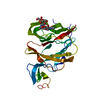 5x4sC  5x58C 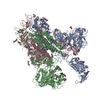 5x59C  5x5bC  5x5cC  5x5fC C: citing same article ( |
|---|---|
| Similar structure data |
- Links
Links
- Assembly
Assembly
| Deposited unit | 
| ||||||||
|---|---|---|---|---|---|---|---|---|---|
| 1 |
| ||||||||
| Unit cell |
|
- Components
Components
| #1: Protein | Mass: 38553.051 Da / Num. of mol.: 1 / Fragment: UNP residues 18-353 Source method: isolated from a genetically manipulated source Source: (gene. exp.)  Production host:  Trichoplusia ni (cabbage looper) / References: UniProt: W6A028, UniProt: K9N5Q8*PLUS Trichoplusia ni (cabbage looper) / References: UniProt: W6A028, UniProt: K9N5Q8*PLUS | ||
|---|---|---|---|
| #2: Polysaccharide | Source method: isolated from a genetically manipulated source #3: Water | ChemComp-HOH / | |
-Experimental details
-Experiment
| Experiment | Method:  X-RAY DIFFRACTION / Number of used crystals: 1 X-RAY DIFFRACTION / Number of used crystals: 1 |
|---|
- Sample preparation
Sample preparation
| Crystal | Density Matthews: 2.5 Å3/Da / Density % sol: 50.82 % |
|---|---|
| Crystal grow | Temperature: 291 K / Method: vapor diffusion, sitting drop / pH: 5.5 Details: 0.2 M Magnesium chloride hexahydrate, 0.1 M BIS-TRIS, 25% w/v Polyethylene glycol 3350 |
-Data collection
| Diffraction | Mean temperature: 100 K |
|---|---|
| Diffraction source | Source:  SYNCHROTRON / Site: SYNCHROTRON / Site:  SSRF SSRF  / Beamline: BL17U / Wavelength: 1.039 Å / Beamline: BL17U / Wavelength: 1.039 Å |
| Detector | Type: ADSC QUANTUM 315 / Detector: CCD / Date: Jun 21, 2014 |
| Radiation | Protocol: SINGLE WAVELENGTH / Monochromatic (M) / Laue (L): M / Scattering type: x-ray |
| Radiation wavelength | Wavelength: 1.039 Å / Relative weight: 1 |
| Reflection | Resolution: 1.5→50 Å / Num. obs: 64228 / % possible obs: 99.7 % / Redundancy: 8.4 % / Net I/σ(I): 27.6 |
| Reflection shell | Resolution: 1.5→1.55 Å / Redundancy: 8.4 % / Mean I/σ(I) obs: 1.6 / Num. unique obs: 6330 / % possible all: 99.7 |
- Processing
Processing
| Software |
| |||||||||||||||||||||||||||||||||||||||||||||||||||||||||||||||||||||||||||||||||||||||||||||||||||||||||||||||||||||||||||||||||||||||||||||||||||||||||||||||||
|---|---|---|---|---|---|---|---|---|---|---|---|---|---|---|---|---|---|---|---|---|---|---|---|---|---|---|---|---|---|---|---|---|---|---|---|---|---|---|---|---|---|---|---|---|---|---|---|---|---|---|---|---|---|---|---|---|---|---|---|---|---|---|---|---|---|---|---|---|---|---|---|---|---|---|---|---|---|---|---|---|---|---|---|---|---|---|---|---|---|---|---|---|---|---|---|---|---|---|---|---|---|---|---|---|---|---|---|---|---|---|---|---|---|---|---|---|---|---|---|---|---|---|---|---|---|---|---|---|---|---|---|---|---|---|---|---|---|---|---|---|---|---|---|---|---|---|---|---|---|---|---|---|---|---|---|---|---|---|---|---|---|---|
| Refinement | Resolution: 1.5→44.338 Å / SU ML: 0.14 / Cross valid method: FREE R-VALUE / σ(F): 1.34 / Phase error: 18.4
| |||||||||||||||||||||||||||||||||||||||||||||||||||||||||||||||||||||||||||||||||||||||||||||||||||||||||||||||||||||||||||||||||||||||||||||||||||||||||||||||||
| Solvent computation | Shrinkage radii: 0.9 Å / VDW probe radii: 1.11 Å | |||||||||||||||||||||||||||||||||||||||||||||||||||||||||||||||||||||||||||||||||||||||||||||||||||||||||||||||||||||||||||||||||||||||||||||||||||||||||||||||||
| Refinement step | Cycle: LAST / Resolution: 1.5→44.338 Å
| |||||||||||||||||||||||||||||||||||||||||||||||||||||||||||||||||||||||||||||||||||||||||||||||||||||||||||||||||||||||||||||||||||||||||||||||||||||||||||||||||
| Refine LS restraints |
| |||||||||||||||||||||||||||||||||||||||||||||||||||||||||||||||||||||||||||||||||||||||||||||||||||||||||||||||||||||||||||||||||||||||||||||||||||||||||||||||||
| LS refinement shell |
|
 Movie
Movie Controller
Controller


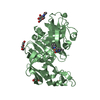
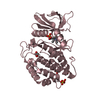





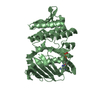
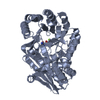

 PDBj
PDBj
